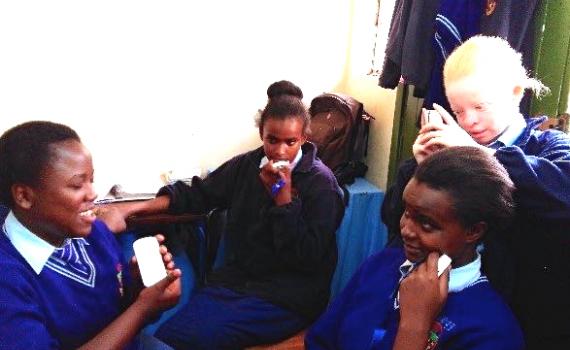
During their regular outreach visits to schools, Nairobi Area librarians noticed that in order to study, five or more blind and visually impaired children were crowding around one braille textbook. Some textbooks were only available in print, and the children would have to wait for teachers or sighted students to read the books aloud to them. For leisure reading, the situation was the same - schools did not have enough braille or audio books to serve blind and visually impaired children’s needs.
The lack of books in accessible formats means that blind and visually impaired students struggle to study and cannot keep up with their sighted classmates.
THE INNOVATIVE PROJECT
The librarians designed a project that would increase the library’s capacity to create accessible format text, and bring them to blind and visually impaired students through the library’s mobile outreach service.
With a small grant from the EIFL Public Library Innovation Programme, and matching funding from the Kenya National Library Service (KNLS), the librarians launched a project titled ‘Breaking the barrier: Use of assistive technologies in information dissemination’.
MAIN ACTIVITIES
- Stakeholder consultation and building partnerships: To refine the project and bring partners on board, the library consulted with the Kenyan Institute for the Blind and the Kenyan Union for the Blind, teachers and visually impaired library users.
- Purchase of equipment: The library purchased and installed two laptop computers; a flatbed scanner; braille conversion software; paper for printing in braille, and 12 DAISY readers to create and play back audio books (DAISY is short for Digital Audio Information System).
- Selecting titles: Working with teachers, librarians identified the most-needed textbooks for conversion into both braille and DAISY audio formats. The librarians also selected story books based on their popularity, using library lending statistics as a guide.
- Training librarians and creating accessible format books: After a three-day practical skills workshop, seven librarians began creating accessible format books.
- Bringing the books to schools: Every week the mobile library outreach service travels to schools up to 80 kilometres outside Nairobi, bringing the new accessible format copies, in braille and DAISY audio formats, for the children to read.
PROJECT TIMELINE
April 2016 – March 2017
ACHIEVEMENTS AND IMPaCt
The project -
- Increased the library’s stocks of braille and audio books: The library has created 80 textbooks and storybooks in braille and video formats.
- Increased access to knowledge for blind and visually impaired schoolchildren: The mobile library travels to 49 schools in the Nairobi area, bringing braille and audio books to over 500 blind, visually impaired and otherwise print-disabled children.
- Increased children’s skills and confidence with braille, and audio technology, and their motivation to study: Using the new resources, blind and visually impaired children are now learning at the same pace as their sighted classmates.
- Raised awareness about different kinds of assistive technology: Teachers and students are now more aware of the range of technology and options for creating and accessing texts in different accessible formats.
- Built a sustainable base for creating accessible format copies: With the new equipment, and skilled librarians, the library is continuing to produce accessible format text.
- Created a space for blind and visually impaired people in the library: A new area for blind and visually impaired people in the library’s centre for people living with disability includes a computer with JAWS screen reading software, braille and large-print books, and DAISY readers.
- Increased the number of blind and visually impaired people using the library: The number of regular visitors to the library’s centre for people living with disability has increased. Numbers of telephone enquiries about accessible format resources have also increased, and the library delivers requested texts to over 500 blind and visually impaired people at schools, homes and social centres in and around Nairobi.
- Strengthened old and built new partnerships: The project strengthened the library’s existing partnerships and created new partnerships with organizations serving blind and visually impaired people and with schools and teachers.
THE FUTURE
Kenya National Library Service is continuing to fund the programme. When preparing for school visits, librarians are able to ensure that the mobile library is well stocked with accessible format books for blind and visually impaired learners.
In June 2017, Kenya ratified the Marrakesh Treaty, an international treaty that enables libraries to make accessible format copies of printed works for use in education and research, and to share them across borders. When the Treaty is implemented into national law, it will offer new opportunities to libraries to increase services to blind and visually impaired users.
MORE PUBLIC LIBRARIES SUPPORTING EDUCATION
Read about more innovative public library services supporting education of children and adults. PLIP-EDUCATION





